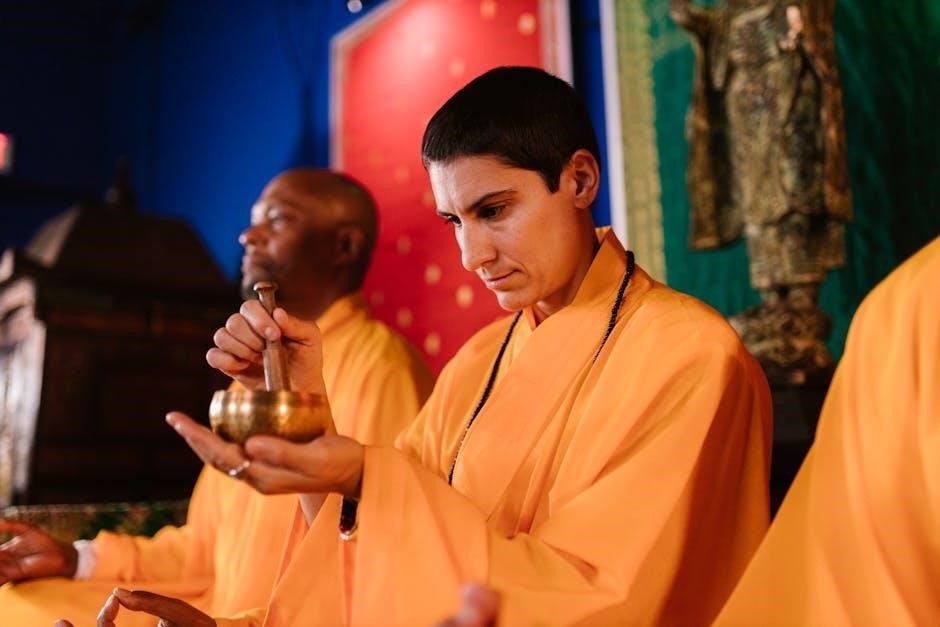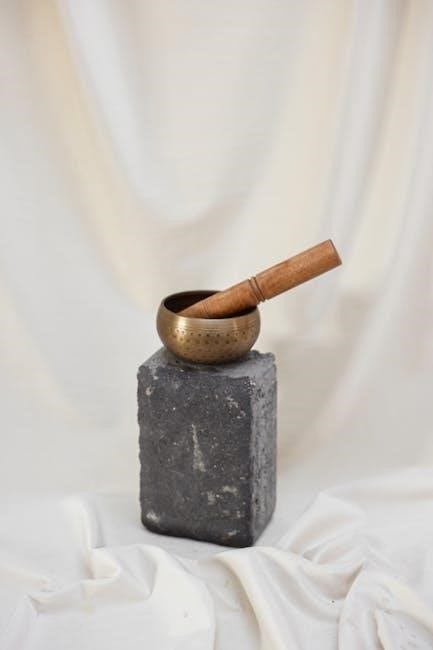The 5 Tibetan Rites are an ancient yoga practice discovered by Colonel Bradford in a Himalayan monastery, popularized by Peter Kelder in 1939. These exercises, known for their simplicity and effectiveness, combine movement and breath to activate the body’s energy flow, promoting vitality, longevity, and spiritual balance. Originating from Tibetan monks, they are believed to rejuvenate the body and mind, offering a holistic approach to health and wellness.
Brief Overview of the 5 Tibetan Rites
The 5 Tibetan Rites are a series of five exercises rooted in ancient Tibetan yoga, designed to promote physical, mental, and spiritual well-being. Originating from Himalayan monasteries, these rites were popularized by Peter Kelder in his 1939 book, The Eye of Revelation. Each exercise targets specific areas of the body, such as the spine, core, and joints, while also balancing the body’s energy flow. The rites are simple yet powerful, requiring only 10-15 minutes daily. They are believed to enhance vitality, flexibility, and longevity, making them a popular practice for those seeking holistic health and rejuvenation. The exercises have gained worldwide recognition for their transformative benefits and are widely shared through guides and PDF tutorials.
Historical Background and Significance
The 5 Tibetan Rites trace their origins to ancient Tibetan yoga practices, deeply rooted in Himalayan monasteries where monks performed these exercises for centuries. The rites were first introduced to the Western world by Colonel Bradford, a British officer who encountered them during his time in Tibet. Peter Kelder later popularized the exercises in his 1939 book, The Eye of Revelation, revealing these once-secret rituals to a global audience. The rites are believed to have been developed to maintain youthful vitality, balance the body’s energy, and connect with the seven major chakras. Their historical significance lies in their preservation of ancient wisdom and their enduring appeal as a holistic practice for health and longevity.
Importance of the 5 Tibetan Rites in Modern Times
The 5 Tibetan Rites hold significant relevance in today’s fast-paced world, offering a simple yet profound practice for holistic well-being. Originating from ancient Tibetan yoga, these exercises were popularized by Peter Kelder in 1939 as a means to rejuvenate the body and mind. Modern lifestyles often lead to stress, physical stagnation, and energy imbalances, making the rites a valuable tool for restoring vitality. By aligning the body’s chakras and enhancing energy flow, the rites provide a natural way to improve physical strength, mental clarity, and emotional balance. Their convenience—requiring just 10-15 minutes daily—makes them accessible to anyone seeking a timeless solution for modern health challenges.

History and Origins of the 5 Tibetan Rites
The 5 Tibetan Rites were discovered by Colonel Bradford in a Himalayan monastery and popularized by Peter Kelder in 1939. Originating from Tibetan monks, they aim to promote longevity and vitality.
Discovery by Colonel Bradford
Colonel Bradford, a British army officer, discovered the 5 Tibetan Rites during his stay in a Himalayan monastery in the early 1900s. He observed Tibetan monks performing these exercises daily, which they believed enhanced vitality and promoted longevity. Intrigued by their youthful energy and vigor, Bradford learned the rites and brought them back to the West. His findings were later popularized by Peter Kelder in the 1939 book The Eye of Revelation, introducing the practice to a global audience. The rites, rooted in ancient Tibetan traditions, were believed to activate the body’s energy flow, harmonize the chakras, and rejuvenate the body and mind. This discovery marked the beginning of their widespread adoption as a holistic wellness practice.
Role of Peter Kelder in Popularizing the Rites
Peter Kelder played a pivotal role in introducing the 5 Tibetan Rites to the Western world through his 1939 book, The Eye of Revelation. Kelder, inspired by Colonel Bradford’s discovery, detailed the exercises and their purported benefits, framing them as a “Fountain of Youth.” His work not only explained the physical movements but also emphasized their spiritual and energetic effects, such as chakra activation and life-energy stimulation. Kelder’s book became a cornerstone for modern practitioners, offering clear instructions and inspiring widespread adoption. His efforts transformed the rites from a monastic practice into a global phenomenon, accessible to anyone seeking holistic health and vitality.
Evolution of the Practice Over Time
Originally practiced by Tibetan monks, the 5 Tibetan Rites evolved from a secret monastic ritual to a widely adopted wellness practice. Over time, interpretations and methods have been refined, incorporating modern yoga principles and safety guidelines. The rites were first popularized in the West by Peter Kelder’s 1939 book, leading to various adaptations and instructional materials, including PDF guides and online tutorials. Today, the practice blends traditional techniques with contemporary modifications, making it accessible to diverse fitness levels. Despite these changes, the core essence of the rites—enhancing vitality and spiritual alignment—remains intact, ensuring their relevance in modern holistic health routines.
Rite 1: The Spin
Rite 1 involves spinning clockwise with arms extended, activating the body’s energy flow and balancing the chakras. This simple yet powerful movement enhances vitality and mental clarity, promoting overall well-being and alignment.
Technique and Proper Form
For Rite 1, stand erect with arms extended horizontally at shoulder height. Keep palms facing downward and maintain a steady gaze forward. Spin clockwise, allowing your arms to remain straight and relaxed. Focus on aligning your body vertically, engaging your core for balance. Inhale deeply before starting, then breathe naturally, exhaling as needed. Spin until slight dizziness occurs, then stop gradually. Beginners should start with 3-5 spins and gradually increase. Proper form ensures safety and maximizes benefits, promoting energy flow and chakra alignment. Avoid overexertion and maintain awareness of your surroundings to prevent accidents. Consistent practice enhances equilibrium and vitality.
Benefits and Effects on the Body
Regular practice of Rite 1 enhances circulation, boosting energy and vitality. It stimulates the nervous system, improving coordination and balance. The spinning motion activates the body’s energy flow, particularly in the first and second chakras, promoting emotional and physical harmony. Over time, it may improve posture, reduce stiffness, and increase mental clarity. The exercise also supports hormonal balance, which can lead to rejuvenation and a youthful appearance. Consistent practice strengthens the body’s core and enhances overall flexibility. Mentally, it fosters focus and calmness, reducing stress and anxiety. By aligning the body and breath, Rite 1 prepares the practitioner for deeper spiritual and physical connection in subsequent rites.
Common Mistakes to Avoid
One of the most common mistakes when performing Rite 1 is spinning too quickly, which can lead to dizziness or discomfort. It’s important to start slowly and gradually increase speed as comfort allows. Another mistake is not maintaining proper posture, which can reduce the effectiveness of the exercise. Practitioners should keep their arms straight and parallel to the ground. Overexertion is another pitfall; listen to your body and rest when needed. Ignoring proper breathing techniques can also diminish the benefits. Lastly, some individuals may spin counterclockwise, which is incorrect—always spin clockwise. By avoiding these errors, you can maximize the benefits and ensure a safe, effective practice.

Rite 2: The Leg Raising
Rite 2 involves lying on your back and raising your legs straight up while breathing deeply, targeting the abdominal muscles and lower back. It improves vitality and energy flow, promoting overall wellness and balance.
Step-by-Step Guide to Performing Rite 2
To perform Rite 2, begin by lying flat on your back with your arms extended overhead and legs straight. Engage your core, then lift your legs straight up toward the ceiling while inhaling deeply. Keep your knees slightly bent if necessary for comfort. Hold this position briefly before slowly lowering your legs back down to the starting position while exhaling. Repeat this movement 21 times, focusing on controlled breathing and maintaining a steady rhythm. This rite strengthens the abdominal muscles, improves circulation, and enhances vitality, aligning with the overall goal of balancing energy and promoting longevity.
Targeted Health Benefits
Rite 2, the Leg Raising exercise, offers numerous health benefits, particularly targeting the abdominal muscles, lower back, and internal organs. By lifting the legs, it strengthens the core, improving posture and reducing lower back pain. This rite also enhances blood circulation, promoting vitality and energy flow throughout the body. Additionally, it stimulates the abdominal organs, such as the intestines and liver, aiding in digestion and detoxification. Regular practice of Rite 2 can improve flexibility in the hip joints and strengthen the muscles in the lower abdomen. It also supports the body’s natural detoxification processes, contributing to overall well-being and longevity. This exercise is particularly effective for improving abdominal tone and enhancing metabolic function.
Tips for Effective Practice
For optimal results with the 5 Tibetan Rites, start slowly and gradually increase repetitions. Begin with 3-5 rounds of each rite and build up to 21. Practice on an empty stomach or at least 2 hours after eating. Focus on proper breathing—inhale deeply through the nose and exhale fully through the mouth. Maintain good posture and alignment to avoid strain. Perform the rites in a quiet, distraction-free space to enhance focus and energy flow. Consistency is key; aim to practice daily at the same time. Listen to your body and rest if needed. Combining the rites with mindful breathing amplifies their benefits, promoting balance and vitality.
Rite 3: The Kneeling Backbend
Rite 3 involves kneeling and arching the spine, stretching the chest and shoulders. It strengthens the back, improves posture, and enhances flexibility while energizing the body.
Correct Posture and Alignment
The kneeling backbend, or Rite 3, requires precise posture to maximize its benefits. Begin by kneeling on the floor with your knees hip-width apart and toes tucked under. Place your hands on your lower back or hips, with your fingers pointing downward. Slowly arch your spine, lifting your chest and head toward the ceiling. Keep your shoulders down and away from your ears, and ensure your neck remains in a neutral position. The goal is to create a gentle, natural curve in the upper back without straining. Proper alignment ensures the stretch targets the correct muscles and avoids discomfort or injury.
Breathe deeply and naturally, avoiding forced breaths. Focus on maintaining a steady, relaxed posture throughout the movement. This rite strengthens the back muscles, improves spinal flexibility, and enhances posture when performed correctly.
Therapeutic Effects on the Spine and Internal Organs
Rite 3, the kneeling backbend, offers profound therapeutic benefits for the spine and internal organs. By gently arching the spine, it stretches the thoracic and cervical regions, improving flexibility and reducing tension. This posture also stimulates the abdominal organs, enhancing digestion and detoxification. The backbend helps align the spine, relieving compression and improving posture. Additionally, it strengthens the muscles supporting the spine, reducing the risk of back pain. The deep breathing associated with this rite promotes oxygenation of the organs, further enhancing their function. Regular practice can lead to improved core stability, better organ health, and overall vitality.
This rite is particularly beneficial for individuals with sedentary lifestyles or those seeking to restore spinal health and internal balance.
Modifications for Different Fitness Levels
Rite 3 can be adapted to suit various fitness levels, ensuring accessibility for all practitioners. Beginners may start with a modified backbend, using a cushion under the knees for comfort. Intermediate practitioners can gradually increase the depth of the bend as flexibility improves. Advanced individuals might incorporate breath retention or extend the duration of the pose for enhanced benefits. Additionally, those with knee sensitivity can perform the movement while seated on a chair or use props for support. These modifications allow individuals to tailor the practice to their needs, promoting safe and progressive development of strength and flexibility.
Rite 4: The Tabletop
Rite 4, the Tabletop, strengthens core muscles and improves flexibility. Start on hands and knees, then lift hips to form a flat tabletop position. Hold briefly, engaging breath for stability and alignment.
Proper Execution and Breathing Techniques
To perform Rite 4, the Tabletop, begin on hands and knees. Inhale deeply, then exhale as you lift your hips to form a flat, straight line from head to heels. Engage your core, keep shoulders down, and maintain a neutral spine. Hold the position briefly, focusing on steady breathing to enhance stability and alignment. Proper execution ensures core strength and flexibility, while mindful breathing helps maintain focus and balance throughout the exercise.
Impact on Core Strength and Flexibility
Rite 4, the Tabletop, significantly enhances core strength by engaging the abdominal muscles and spinal extensors. This exercise improves posture and stability while stretching the hamstrings and hips, boosting overall flexibility. Regular practice strengthens the core, essential for maintaining proper spinal alignment and preventing injuries. The dynamic movements also increase blood flow and energy circulation, promoting vitality and resilience. By targeting the central axis of the body, Rite 4 fosters a strong, balanced foundation, which is vital for both physical and mental well-being. Over time, consistent practice leads to improved balance, posture, and enhanced overall physical performance.
Advanced Variations for Enhanced Benefits
For experienced practitioners, incorporating advanced variations into Rite 4, the Tabletop, can amplify its benefits. Adding dynamic movements, such as alternating leg lifts or torso rotations, challenges the core further and enhances flexibility. Holding the tabletop position for longer durations or adding breathwork, like synchronized inhales and exhales, intensifies the exercise. Additionally, incorporating resistance, such as light weights or resistance bands, can strengthen the muscles more effectively. These variations not only deepen the physical challenge but also heighten mental focus and energy flow, offering a more comprehensive practice. They are ideal for those seeking to progress beyond the foundational routine and experience greater physical and energetic transformation.

Rite 5: The Downward and Upward Dog
Rite 5 combines downward and upward dog poses, flowing between them to enhance spinal flexibility and energy flow; It strengthens the arms, shoulders, and hamstrings while aligning the chakras and invigorating the body.
Detailed Instructions for Each Phase
Start by placing your hands on the floor shoulder-width apart. Step your feet back into a high plank position, ensuring your body forms a straight line. Inhale deeply, then exhale as you lift your hips upward, forming an inverted V (Downward Dog). Hold briefly, then lower your chest forward, bending your elbows to transition into Upward Dog, with your palms and toes grounding you. Keep your shoulders down and chest open. Reverse the movement back to Downward Dog, maintaining control and breathing naturally. Repeat the sequence, synchronizing each phase with your breath for optimal energy flow and alignment. Focus on smooth transitions and proper form to maximize benefits.
Energy Flow and Chakra Activation
The 5 Tibetan Rites are designed to stimulate the body’s seven major chakras, enhancing energy flow and balancing the nervous system. By performing each rite with intention and focus, practitioners activate these energy centers, promoting vitality and spiritual harmony. The spinning motion in Rite 1 aligns the root and crown chakras, while Rite 2 strengthens the sacral and solar plexus. Rite 3 opens the heart and throat, Rite 4 energizes the core, and Rite 5 integrates all chakras through dynamic postures. Regular practice harmonizes energy, fostering mental clarity, emotional balance, and a deeper connection to the body’s subtle energies. This holistic approach revitalizes both the physical and spiritual self, embodying the ancient wisdom of Tibetan yoga.
Integration with Other Yoga Practices
The 5 Tibetan Rites can seamlessly integrate with traditional yoga practices, enhancing overall well-being. Start with the Tibetan Rites to energize the body, then transition into yoga asanas for deeper stretches and relaxation. Combine the spinning motion of Rite 1 with balancing poses to improve equilibrium and focus. Pair Rite 2’s leg-raising with core-strengthening asanas for enhanced body strength. Use controlled breathing from yoga to deepen the meditative aspect of the Rites, creating a harmonious flow. For beginners, modify intense movements with alternative yoga poses to ensure safety. This blended practice balances energy flow, promotes vitality, and fosters mental clarity, offering a holistic approach to physical and spiritual health. By merging these practices, one can experience a comprehensive and enriching yoga routine.

Benefits of the 5 Tibetan Rites
The 5 Tibetan Rites enhance physical and mental well-being by boosting vitality, improving flexibility, and activating the seven major chakras. They promote longevity, reduce stress, and increase energy flow, fostering a balanced and rejuvenated body and mind.
Physical Benefits: Strength, Flexibility, and Vitality
The 5 Tibetan Rites significantly enhance physical well-being by improving strength, flexibility, and vitality. Regular practice increases energy levels, boosts circulation, and strengthens muscles, particularly in the core and spine. Rite 1, the spin, enhances balance and coordination, while Rite 3, the kneeling backbend, improves posture and reduces stiffness. Rite 4, the tabletop, strengthens the arms and legs, promoting overall flexibility. Rite 5, the downward and upward dog, enhances full-body circulation and muscle tone. These exercises also improve digestion and reduce joint pain, contributing to a more vibrant and youthful physical state. By stimulating the body’s energy flow, the rites help maintain optimal physical health and vitality.
Mental and Emotional Benefits: Clarity and Balance
The 5 Tibetan Rites offer profound mental and emotional benefits, fostering clarity and balance. By harmonizing the body’s energy flow, these exercises reduce stress and anxiety, promoting a calm and centered mind. Regular practice enhances focus and mental acuity, allowing for sharper concentration and improved decision-making. The rites also cultivate emotional resilience, helping to manage daily challenges with greater ease. Many practitioners report a sense of inner peace and stability, as the exercises align the body’s energy with the mind. This holistic approach not only rejuvenates the physical body but also nurtures mental clarity and emotional equilibrium, leading to a more balanced and fulfilling life.
Spiritual Benefits: Chakra Alignment and Energy Flow
The 5 Tibetan Rites are deeply rooted in spiritual tradition, designed to align the body’s seven major chakras. By performing these exercises, practitioners experience enhanced energy flow, or “prana,” which revitalizes the spiritual body. This alignment promotes a connection to higher consciousness, fostering intuition and inner wisdom. The rites are believed to cleanse and balance the chakras, facilitating spiritual growth and self-awareness. Regular practice helps harmonize the subtle energies, leading to a deeper sense of purpose and unity with the universe. This spiritual dimension of the rites makes them a powerful tool for those seeking not only physical and mental well-being but also profound inner transformation and enlightenment.

How to Perform the 5 Tibetan Rites
Perform each rite 21 times daily, starting with a warm-up. Focus on proper form, breath, and energy flow. Practice consistently for optimal physical, mental, and spiritual benefits.
Preparation and Warm-Up
Begin by finding a quiet, distraction-free space and dressing in loose, comfortable clothing. Start with a clear mind and set an intention for your practice. Warm up with gentle stretches or light cardio to prepare your muscles. Focus on deep, rhythmic breathing to center your energy. Many practitioners recommend starting slowly, especially if new to the rites, to allow your body to adapt. Proper alignment and form are crucial to avoid injury. Take a few moments to ground yourself and connect with your breath before initiating the first rite. This preparation ensures a safe and effective practice, enhancing the rites’ physical, mental, and spiritual benefits.
Daily Practice Routine and Timing
Aim to perform the 5 Tibetan Rites daily, ideally in the morning to boost energy and set a positive tone for the day. Start with 3-5 repetitions of each rite and gradually increase to the recommended 21 times as your body adapts. Each session typically takes 10-15 minutes, making it easy to incorporate into a busy schedule. Consistency is key for optimal benefits. Some practitioners also find practicing at sunset beneficial for winding down. Listen to your body and adjust the timing and repetitions based on your energy levels and comfort. Regular practice fosters discipline and enhances the rites’ rejuvenating effects on both body and mind.
Safety Precautions and Contraindications
Before starting the 5 Tibetan Rites, consult a healthcare provider, especially if you have medical conditions like back problems, dizziness, or high blood pressure. Begin with caution, as spinning (Rite 1) may cause dizziness. Start with fewer repetitions (3-5) and gradually increase to 21 as your body adapts. Avoid overexertion, especially if new to the practice. Pregnant women, individuals with severe injuries, or those with chronic health issues should modify or avoid certain rites. Listen to your body and stop if discomfort arises. Proper form is essential to prevent injury. Warm up before practice and cool down afterward to ensure safety and maximize benefits. Moderation and mindfulness are key to a safe and effective routine.
Variations and Modifications

Variations and Modifications
The 5 Tibetan Rites offer adaptable variations for different fitness levels. Beginners can start with fewer repetitions, while advanced practitioners can add dynamic movements or hold poses longer for enhanced benefits.
Adaptations for Beginners
For those new to the 5 Tibetan Rites, adaptations are essential to ensure safety and gradual progress. Beginners can start with fewer repetitions, such as 3-5 times per rite, and gradually increase as strength and flexibility improve. Modifying poses, like bending knees during the tabletop or performing spins more slowly, can reduce strain. Breathing techniques can also be simplified, focusing on rhythmic inhalation and exhalation rather than advanced pranayama. Additionally, breaks between exercises are encouraged to allow the body to adjust. These modifications help build a strong foundation, making the practice accessible and enjoyable for all fitness levels while maintaining its holistic benefits.
Advanced Practices for Experienced Practitioners
Experienced practitioners of the 5 Tibetan Rites can enhance their practice by incorporating advanced techniques. Increasing repetitions beyond 21, adding dynamic movements, or holding poses longer can deepen the effects. Advanced practitioners may also integrate breathwork, such as synchronized pranayama, to amplify energy flow. Incorporating meditation or visualization during the rites can further align the body, mind, and spirit. Additionally, combining the rites with other yoga or martial arts practices can create a more comprehensive workout. For those seeking greater challenges, variations like single-leg spins or deeper backbends can be explored. Always consult a qualified instructor before advancing to ensure proper form and safety.
